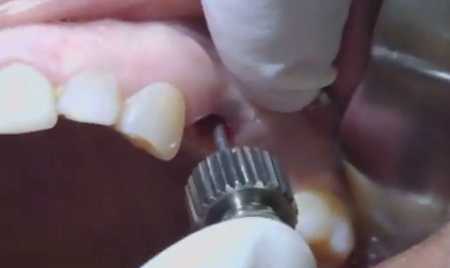An incisionless (non surgical) implant is when an implant is placed in the extraction site of a newly extracted tooth.
What Is Incision-free Implantation?
For those who want to become the owner of “new teeth” in the shortest possible time and with minimal trauma to the gums, there is a special technology in dental practice. Incision-free implantation is a technique that differs from classic implantation protocols and has its own peculiarities.
The surgeon places the implant without incising the gum and separating the gum tissue flap. Naturally, surgery is still needed – the implant is placed into the bone tissue through a small hole in the gum, but it does not exceed a few millimeters. This is why the procedure is called “non-surgical dental implantation”, “incision-free implants”.
How Does It Differ From Incision-free Implantation?
This technique is most commonly used for one-step or immediate implantation – when your own tooth has just been extracted.
Since the doctor cannot see through the puncture hole exactly how the implant is placed, special equipment and 3D modeling are used for the procedure. A special template is made, guides are set – and the implant is inserted through the hole into the bone in the right place and at the right angle.
This way, the gums are not damaged and no stitches are removed.
Who Is the Best Candidate for Intraoperative Implantation?
The method of incision-free implantation can be indicated for those who want to restore one lost tooth (one implant, one tooth) or by means of a multi-tooth restoration to compensate the missing teeth, for example, in the case of a completely edentulous jaw.
Clinical practice shows that the indication for this method of implantation is very individual. Here the surgeon and the prosthodontist have the final say and can weigh the pros and cons of this technique.
Why Do Patients Choose Incision-free Implantation?
Dentists note that patients choose gum incisionless implantation solely for psychological reasons. It is considered to be less painful and traumatic. Patients are afraid of the sight of blood, of what they saw in the pictures online.
We want to dispel these fears:
- The patient won’t have to see the implant process – only the surgeon will see a picture of the incision.
- Pain during the procedure is completely eliminated – this is simply out of the question. Our clinics use reliable anesthesia and, if needed, sedation.
- But some of the pain after implantation is not caused by the gum. The gum, like all mucosa, heals very quickly and the removal of stitches is a very quick and comfortable procedure.
How Does an Incision-free Implant Procedure Work?
The first step is to have a Cone Beam Computed Tomography (CBCT.) Based on the results of the scan, a special program is used to mark where and at what angle the implants will be placed. In the lab, a surgical template is made where the exact position of the implant is marked. The surgeon then performs the surgery to place the implant through a small hole in the gum.
Pros and Cons of Incision-free Implants
The main advantages of this implant technique are twofold:
- Shorter healing time;
- Reduced time for the placement of permanent dentures – with the classic version it takes about six months, with the “incision-free” method it takes a month to a month and a half.
But the risks are present too, and they are serious enough. Doctors recommend paying attention to the following points:
- In order to install an implant qualitatively, to completely eliminate the possibility of complications, a great deal of experience, very thorough preparation of the surgeon and perfect modeling before implantation is required.
- Despite the absence of incisions, the technique does not exclude the possibility of defects of the oral mucosa.
The conclusion from all of the above is the following: it is better to rely on the opinion of an experienced surgeon-implantologist when choosing the best method of implantation.






